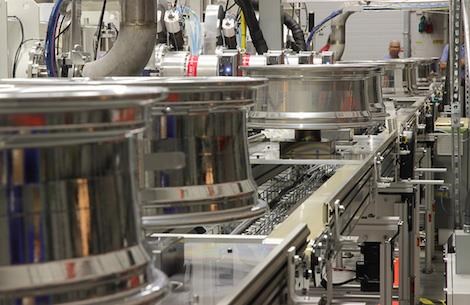Dynavac Announces Partnership with Winona PVD Coatings
System’s modular design incorporates multiple process stations, proprietary high-duty chamber isolation valves, and an integrated wheel handling system.
#vacuum-vapor

Dynavac, a leader in the manufacturer of thin film deposition systems, says that it has entered into an exclusive supply agreement with Winona PVD Coatings of Warsaw, Indiana, to produce Inline Production Systems that support growing demand for its G-Chrome deposition process.
Featured Content
This partnership reflects a trend in the automotive industry to produce a high-end chrome wheel finish using a less costly and more environmentally responsible alternative to traditional chrome plating and cladding.
“When Winona experienced a rapid demand for PVD-coated wheels, they asked Dynavac to develop a system to convert their batch manufacturing process into a continuous production line,” says Tom Foley, CEO of Dynavac. “Our team stepped up to the challenge, delivering a turnkey solution that processes wheels in record time while upholding Winona’s high standards for appearance and durability.
Spanning over 50 feet long, Dynavac’s high-throughput system provides a completely automated, continuous manufacturing process that produces wheels in record time. The system’s modular design incorporates multiple process stations, proprietary high-duty chamber isolation valves, and an integrated wheel handling system. Its custom-designed automation system provides precision control of the entire process from start to finish.
“This partnership highlights Dynavac’s expertise in developing advanced thin film production systems for high-demand operating environments,” says Tom Foley, CEO. “We are very pleased to be Winona’s sole supplier of PVD systems and look forward to supporting them as they continue to strengthen their production capabilities.”
RELATED CONTENT
-
Extending Bath Life and Reducing Process Challenges in Vapor Degreasing Systems
How using a stabilizer can extend your bath life and help you avoid costly system repairs.
-
Vacuum Deposition and Coating Options
This overview takes a look at vacuum deposition technologies as processes that may be used to create coatings that can be substituted for or enhances the properties of electroplated coatings. Initially, this work discusses trends in metal finishing and environmental regulation.
-
Plastics and Plating on Plastics [1944]
This republished 1944 AES convention paper presents an historic perspective of the early days of plastics in surface finishing - using them and plating on them, in the waning years of World War II. The discussion reviews the uses of plastics in plating equipment and processing at that time, as well as the coating of the plastics themselves, with accompanying application photos. You will note that today’s conventional plating-on-plastics processes lay far in the future. Surprisingly, CVD processes are discussed.


















